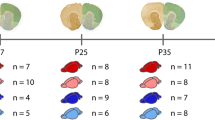Summary
A technique is described which has been used to quantitate the 3-dimensional configuration of the midbrain dopamine (DA) nuclei (cell groups A8, A9, and A10). This technique provides cell counting information, for example, the BALB/c mouse has approximately 25,000 midbrain DA neurons, the albino rat has about 40,000 neurons, and man (33 year old) has approximately 450,000 neurons. Furthermore, cell density topography maps were constructed which enable quantitation of the 3-dimensional cellular distribution. These topography maps revealed both similarities and differences across the three species examined. The number of midbrain DA neurons is known to be genetically determined and to decrease with aging. DA cell number is also related to motoric behavior and neurologic and perhaps psychiatric disease. The ability to quantitate DA regional cell densities represents a new technique which can be used to study the neurobiology of DA neurons and relate DA cell number to both normal and abnormal behaviors.
Similar content being viewed by others
References
Blessing, W. W., Chalmers, J. P., Howe, P. R. C.: Distribution of catecholaminecontaining cell bodies in the rabbit central neurons system. J. Comp. Neurol.179, 407–424 (1978).
Dahlström, A., Fuxe, K.: Evidence for the existence of monoamine containing neurons in the central nervous system. I. Demonstration of monoamines in the cell bodies of brainstem neurons. Acta Physiol. Scand.62 (Suppl.232), 1–55 (1964).
Fallon, J. H., Moore, R. Y.: Catecholamine innervation of the basal forebrain: IV. Topography of the dopamine projection to the basal forebrain and neostriatum. J. Comp. Neurol.180, 545–580 (1978).
German, D. C., Harden, H., Sanghera, M. K., Mann, D., Kiser, R. S., Miller, H. H., Shore, P. A.: Dopaminergic neuronal responses to a non-amphetamine CNS stimulant. J. Neural Transm.44, 39–49 (1979).
German, D. C., McDermott, K.L., Sanghera, M.K., Schlusselberg, D.S., Smith, W. K., Woodward, D.J., Speciale, S. G., Saper, C. B.: Three-dimensional reconstruction of dopamine neurons in the mouse: strain differences in regional cell densities and pharmacology. Neurosci. Abstr.9 (1983 a, in press).
German, D. C., Sanghera, M.K., Trulson, M.E.:In vivo andin vitro electrophysiological studies of mouse dopamine neurons. 5th Internat. CA Sym. (1983 b, in press).
Graham, D. G.: On the origin and significance of neuromelanin. Arch. Path. Lab. Med.103, 359–362 (1979).
Mackay, A. V. P., Iversen, L. L., Rossor, M., Spokes, E., Bird, E., Arregui, A., Creese, I., Snyder, S. H.: Increased brain dopamine and dopamine receptors in schizophrenia. Arch. Gen. Psychiat.39, 991–997 (1982).
McGeer, P. L., McGeer, E. G., Suzuki, J. S.: Aging and extrapyramidal function. Arch. Neurol.34, 33–35 (1977).
Nobin, A., Bjorklund, A.: Topography of monoamine neurone systems in the human brain as revealed in foetuses. Acta Physiol. Scand., Suppl. 388, 1–40 (1973).
Owen, D. G. C., Johnstone, E. C., Frith, C. D.: Spontaneous involuntary disorders of movement. Arch. Gen. Psychiat.39, 452–461 (1982).
Pearson, J., Goldstein, M., Markey, K., Brandeis, L.: Human brainstem catecholamine neuronal anatomy as indicated by immunocytochemistry with antibodies to tyrosine hydroxylase. Neurosci.8, 3–32 (1983).
Reis, D. J., Baker, H., Fink, J. S., Joh, T. H.: A genetic control of the number of dopamine neurons in mouse brain: Its relationship to brain morphology, chemistry, and behavior. In: Genetic Research Strategies for Psychobiology and Psychiatry (Gershon, E. S., Matthysse, S., Breakefield, X. O., Ciaranello, R. D., eds.), pp. 215–229. Boxwood Press. 1981.
Saper, C. B., Petito, C. K.: Correspondence of melanin-pigmented neurons in human brain with A1–A14 catecholamine cell groups. Brain105, 87–101 (1982).
Schlusselberg, D. S., Smith, W. K., Culter, B. G., Woodward, D. J.: A computer system for semi-automatic cell recognition in neuroanatomic studies. Neurosci. Abstr.8, 644 (1982).
Schlusselberg, D. S., Smith, W. K., Lewis, M. H., Culter, B. G., Woodward, D. J.: A general system for computer based acquisition, analysis and display of medical image data. Proc. ACM, 18–25 (1982).
Schmidt, M. J., Sawyer, B. D., Perry, K. W., Fuller, R. W., Foreman, M. M., Ghetti, B.: Dopamine deficiency in the Weaver mutant mouse. J. Neurosci.2, 376–380 (1982).
Shepard, P., German, D. C.: Substantia nigra dopamine neurons: Relationship between cell firing properties, anatomical localization and autoreceptor sensitivity. Neurosci. Abstr.8, 921 (1982).
Shimada, S., Ishikawa, M., Tanaka, C.: Histochemical mapping of dopamine neurons and fiber pathways in dog mesencephalon. J. Comp. Neurol.168, 533–544 (1976).
Sternberger, L. A.: Immunocytochemistry. New York: J. Wiley. 1979.
Tanaka, C., Ishikawa, M., Shimada, S.: Histochemical mapping of catechol-aminergic neurons and their ascending fiber pathays in the rhesus monkey brain. Brain Res. Bull.9, 255–270 (1982).
Understedt, U.: Stereotaxic mapping of the monoamine pathways in the rat brain. Acta Physiol. Scand., Suppl. 367, 1–48 (1971).
Author information
Authors and Affiliations
Rights and permissions
About this article
Cite this article
German, D.C., Schlusselberg, D.S. & Woodward, D.J. Three-dimensional computer reconstruction of midbrain dopaminergic neuronal populations: From mouse to man. J. Neural Transmission 57, 243–254 (1983). https://doi.org/10.1007/BF01248996
Received:
Issue Date:
DOI: https://doi.org/10.1007/BF01248996




